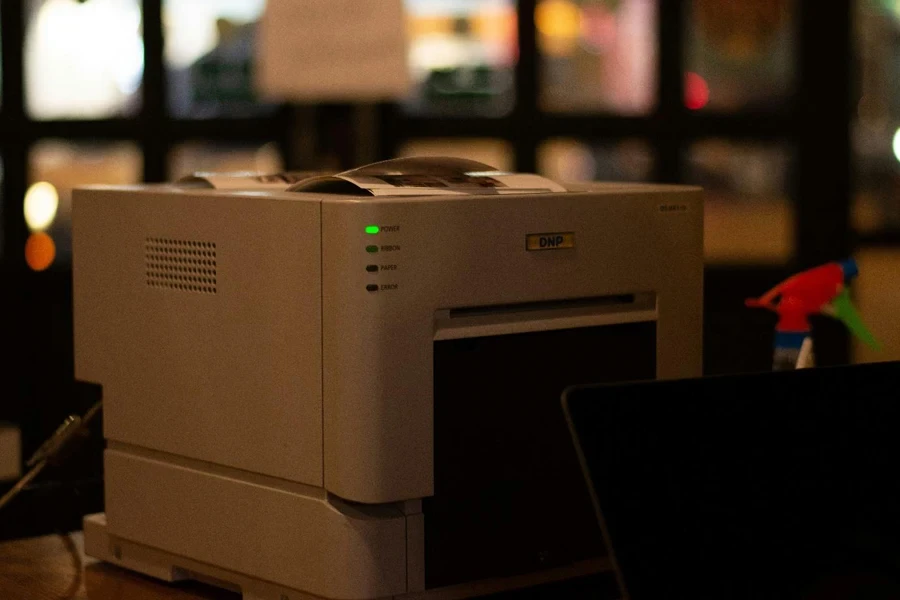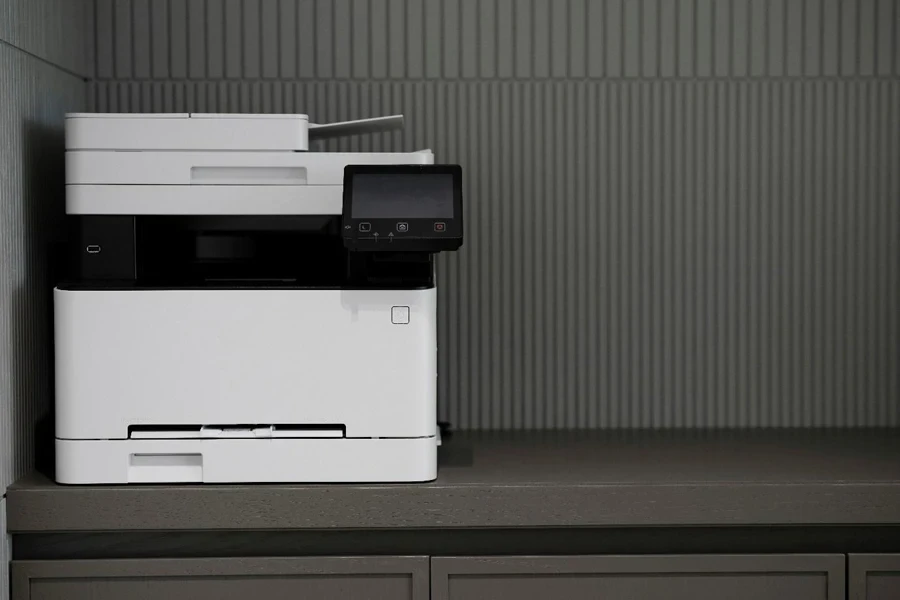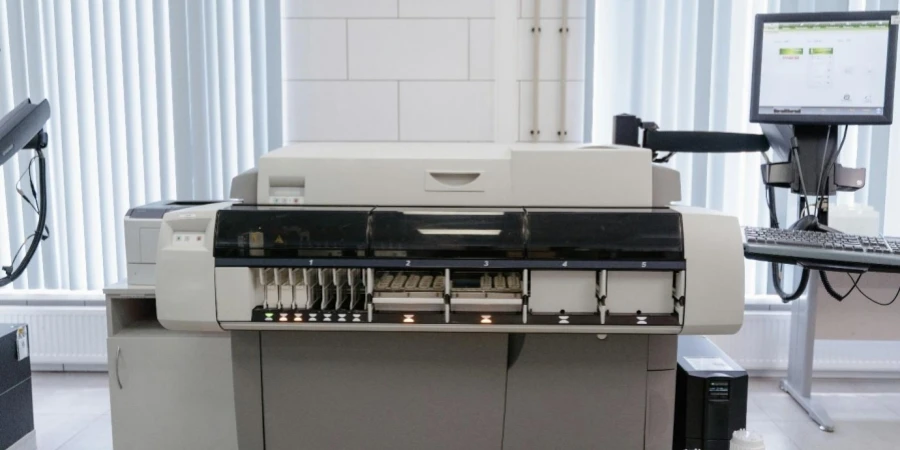Table of Contents
● Introduction
● Market overview
● Key technology and design innovations
● Top-selling models driving market trends
● Conclusion
Introduction
The printer and scanner sector is changing swiftly due to technological advancements and evolving consumer preferences. Innovations like printing speeds, environmentally friendly materials, and automation powered by artificial intelligence have reshaped the market landscape. Moreover, the industry expansion is fueled by the increasing desire for cost-effective models that efficiently handle large volumes.
This article explores the recent shifts in printing and scanning technology trends driven by key technological innovations and popular models on the market today. Stay updated on the changes shaping the future landscape of printing and scanning technology.
Market overview

Market scale and growth
According to market data reports, the value of the global printer market is expected to increase from USD 49.43 billion in 2023 to USD 75 billion by 2032 at a CAGR of 4%. This growth is attributed to improvements in printer technology, such as better resolution and faster printing speeds, alongside features like wireless connectivity and IoT integration, aimed at boosting productivity and cutting operational expenses. The increasing need for color printing and packaging is driven by the growth of e-commerce, which promotes market expansion.
Market segmentation
The market is divided into categories based on printer type, technology type, printer interface, output type, and end-user application preferences. Standalone printers are leading the market due to their ability to work independently and are expected to grow at a CAGR of 5.1%. Multi-functional printers (MFPS), which offer document management solutions, are also becoming increasingly popular. Inkjet printers are the choice in terms of technology, with an estimated growth rate of 5.6%, thanks to their high-quality photo output and versatility in various materials. Regarding the distribution of market dominance, the Asia Pacific region is currently in the lead with a significant market share increase, growing at a compound annual growth rate of 5.9%, closely followed by North America, which is evolving at a rate of 3.5%. Both regions are embracing printing technologies to drive progress.
Key drivers
Market growth is fueled by important factors such as the growing use of mobile printing and the transition from traditional to digital printing in both black and white and color formats. Additionally, there is an increasing need for cloud computing and software solutions. Incorporating AI, machine learning (ML), and the Internet of Things (IoT) presents opportunities for creating personalized and effective printing solutions. This also helps promote sustainability through eco materials and UV-cured inks.
Key technology and design innovations

Advanced printing technologies
Cutting-edge printing methods are revolutionizing the industry scene to an extent these days. In 3D printing technology, selective laser sintering (SLS) and fused deposition modeling (FDM) are utilized. These techniques work together to craft detailed designs while minimizing material wastage, thus improving the efficiency of prototyping and production processes. Furthermore, advancements such as high-speed inkjet technology have emerged in printing, providing quick and high-quality outputs suitable for small-scale projects and personalized customization requests. The advancement of UV light emitting diode (LED) technology enables easy drying of ink on different materials, such as those sensitive to heat, which broadens the scope of surfaces and uses for printing applications. With the introduction of inkjet inks with high viscosity levels, textured and embossed effects can be achieved on printouts, leading to improved versatility and practicality.
Efficiency and automation
Printing processes are becoming more efficient and automated thanks to the combination of AI (Artificial Intelligence), ML (Machine Learning), and IoT (Internet of Things). Smart printing management systems use machine learning algorithms to oversee print setups in time and forecast maintenance requirements while automating tasks to lessen human involvement and improve accuracy levels. Robots in printing facilities manage materials efficiently by loading printers and handling print activities to maintain high-quality results with minimal downtime. These technologies work together to streamline operations effectively and boost productivity while ensuring output quality throughout the process.
Sustainability trends
The printing industry is moving towards sustainability by emphasizing conscious practices and materials such as soy-based and water-based inks to lower volatile organic compound (VOC) emissions and offer safer, renewable, and eco-friendly alternatives; the development of substrates from sources like corn starch creates sustainable options that reduce waste while preserving the environment. Additionally, adopting nanoparticle inks enhances the color intensity and longevity in printed materials while lowering the impact.
Security and customization
Ensuring security and tailored features are gaining significance in printing solutions nowadays. Developments in security printing techniques, like color-shifting inks and holographic watermarks, contribute to improving counterfeiting efforts. These technologies exhibit varying appearances based on viewing angles. Provide an added level of authentication that is hard to duplicate. Sophisticated watermarks integrated into the substrate during printing deliver heightened security owing to their patterns and complicated production processes. The need for customized printing solutions is increasing as people seek accurate ways to create personalized products through digital and advanced inkjet printing technologies.
Top-selling models driving market trends

High-speed and high-volume printers
Businesses in need of fast and efficient printing rely heavily on speed and high-volume printers like the Epson Workforce Pro WF‐4830 model, with its remarkable speed of up to 25 pages per minute and dual 250-sheet trays for ample paper storage capacity to handle large printing tasks effortlessly. Moreover, these printers have features such as automatic document feeders and duplex printing that simplify workflows and significantly boost productivity. Their ability to generate polished and precise written content is invaluable in fast-paced office settings where clarity and efficiency are crucial.
Budget-friendly options
Affordable choices offer bang for your buck while maintaining high-quality standards! Take the Brother MFC J1010DW, a cost-all-in-one printer that allows wireless connections and mobile printing capabilities. It boasts printing speeds of up to 12 pages per minute and comes in a compact design that suits small office spaces and homes perfectly. This model guarantees crisp text and accurate color output at its lower cost range, making it a handy selection for daily use. For those seeking a blend of affordability and functionality, the reasonable price point and key features make it a perfect fit for their product choice.

Innovative photo and label printers
Cutting-edge photo and label printers cater to printing requirements by providing precise color reproduction and detailed output quality. The Canon Pixma TR4720 stands out in this field by producing photo prints at a resolution of up to 4800 x 1200 dpi. It is compatible with various media formats, such as photo paper and label sheets, while offering borderless printing functionality. This versatility makes it an ideal choice for both endeavors and business tasks. These printers are perfect for photographers and small business owners looking for high-quality image printing thanks to their cutting-edge ink technologies and accurate color reproduction capabilities.
Subscription-based ink services
Subscription-based ink services are changing how consumers make decisions and impacting market trends by offering a budget-friendly option for handling ink needs. The HP OfficeJet Pro 9125e serves as an illustration of a printer that leverages these services. With the HP Instant Ink subscription plan, users automatically get cartridges sent to them when ink levels run low. This ensures operation without the need for manual intervention. The service features a cost structure that helps businesses and individuals better plan their printing costs. Subscription services make it easier to ensure your printer works smoothly and consistently while simplifying the task of managing ink supplies.
Conclusion
The printer and scanner industry is poised for expansion due to continuous technological progress and changing consumer needs. Innovations in printing speeds, environmentally friendly materials, and automation are influencing the future trajectory of this sector.
With the continued advancement of these technologies in the years ahead, we can anticipate a greater degree of dynamic and impactful changes in the market scene that will boost efficiency and eco-friendliness for companies globally.




